Related Research Articles

Shotokan is a style of karate, developed from various martial arts by Gichin Funakoshi (1868–1957) and his son Gigo (Yoshitaka) Funakoshi (1906–1945). Gichin Funakoshi was born in Okinawa and is widely credited with popularizing "karate do" through a series of public demonstrations, and by promoting the development of university karate clubs, including those at Keio, Waseda, Hitotsubashi (Shodai), Takushoku, Chuo, Gakushuin, and Hosei.
Kyokushin (極真) is a style of karate originating in Japan. It is a full-contact style of stand-up fighting and is rooted in a philosophy of self-improvement, discipline, and hard training.
The following outline is provided as an overview of and topical guide to martial arts:
Keigo Abe was a prominent Japanese master of Shotokan karate who founded the Japan Shotokan Karate Association in 1999 and is its Chief Instructor. He held the rank of 9th dan in karate, was a direct student of Masatoshi Nakayama (1913–1987), and was a senior instructor in the Japan Karate Association.
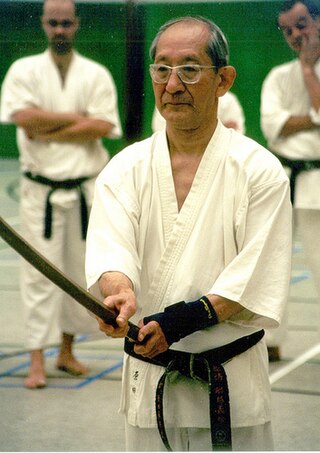
Mitsusuke Harada, MBE was a prominent Japanese master of Shotokai karate who introduced this martial art to Brazil and was after based in the United Kingdom. He founded the Karate-do Shotokai (KDS) organisation in 1965 and was its president. Harada held the rank of 5th dan, personally awarded by Gichin Funakoshi in 1956.
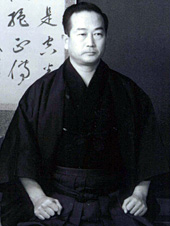
Masatoshi Nakayama was an internationally famous Japanese master of Shotokan karate. He helped establish the Japan Karate Association (JKA) in 1949, and wrote many textbooks on karate, which served to popularize his martial art. For almost 40 years, until his death in 1987, Nakayama worked to spread Shotokan karate around the world. He was the first master in Shotokan history to attain the rank of 9th dan while alive, and was posthumously awarded the rank of 10th dan.
Dōjō kun (道場訓) is a Japanese martial arts term literally meaning "training hall rules." They are generally posted at the entrance to a dōjō or at the "front" of the dōjō (shomen) and outline behaviour expected and disallowed. In some styles of martial arts they are recited at the end of a class.
Randall G. Hassell was the Chief Instructor for the American Shotokan Karate Alliance (ASKA), Senior Editor of Tamashii Press, President of the American JKA Karate Association (AJKA), and a Founding Fellow of the International Karate Society (IKS).

Tsutomu Ohshima is a prominent Japanese master of Shotokan karate who founded the organization Shotokan Karate of America (SKA). He is the Shihan of the SKA, and to this day holds the rank of 5th dan, which was awarded to him by Gichin Funakoshi. Ohshima's branch of the Shotokan world has become known as “Shotokan Ohshima Karate-do.”
Kazumi Tabata was an 8th degree Grand Master in Shotokan karate. Born in Japan in 1943, Master Tabata started karate at age 13 and received the rank of nidan in Shorinji as a freshman in high school. Master Tabata went to Waseda University and started studying Shotokan style karate under Master Isao Obata, one of Master Gichin Funakoshi's first students and first chairman of the Japan Karate Association. He founded the North American Karate-Do Federation (NAKF) and the New England Collegiate Karate Conference (NECKC), and lived in Massachusetts in the United States where he taught regularly until his death in 2020.
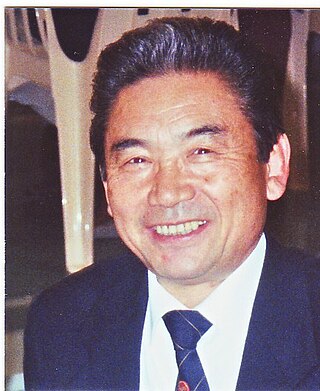
Takayuki Mikami is a Japanese master of Shotokan karate based in the United States of America. He holds the rank of 9th dan black belt in the art, awarded under the Japan Karate Association. In 1958, Mikami tied for first place in the All Japan Karate Championships. The following year, he became the All Japan champion in kumite (sparring) as well as kata (patterns). In 1961, Mikami won first place in kata again. He was also the first person to graduate from the Japan Karate Association's (JKA) instructor training program instituted by Gichin Funakoshi and Masatoshi Nakayama.
James Yabe is a Japanese-American martial arts instructor, and author. One of the oldest students of Hidetaka Nishiyama starting in 1961, Yabe is considered one of the great instructors of Japanese traditional Shotokan Karate.
Black Belt (2007), known as Kuro-obi (黒帯) in Japan, is a Japanese film directed by Shunichi Nagasaki. It focuses mainly on the martial art of Karate. It is notable for excluding the usual exaggerations of the genre. The lead roles were played by karate experts, and no special effects were used.
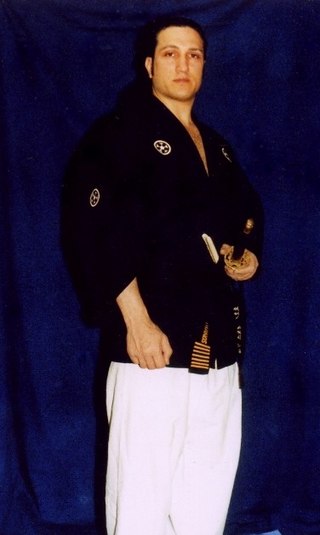
George Spiro Thanos is a martial artist champion. Thanos was born in Bethesda, Maryland, in 1952. He began his martial arts training at the Kim Studio in Silver Spring, Maryland in 1965 at the age of 13.
Alan Ruddock was an Irish Martial Arts pioneer, teacher and writer. He introduced both Aikido & Karate to Ireland and was the founder of the Aiki no Michi and its interpretation of Aikido. Ruddock was one of the few western Aikido practitioners and only Irish national who studied directly under the founder of Aikido, Morihei Ueshiba ("O-Sensei").
John Corcoran was an American non-fiction book author, magazine editor, screenwriter and martial arts historian.

Glenn R. Keeney was an American martial artist. He was born to Walter Russell and Lucy Puckett Keeney in Anderson, Indiana in 1942, and began his karate training in 1957.
Stan Schmidt was a South African master of Shotokan karate. Along with others, such as Norman Robinson, he was an early practitioner of Shotokan karate in South Africa and his establishment of the South African branch of the Japan Karate Association (JKA) in 1965 after training in Japan, along with his subsequent promotion of the art in South Africa, earned him the appellation of 'The Father of South African Karate'. In 1963, he was one of the first westerners to be invited into the JKA's famous Instructor Class in the Tokyo Honbu dojo and he was later one of four non-Japanese karateka to sit on the JKA's international Shihankai. He was also the first non-Japanese karateka to attain 7th dan from the JKA and also the first to attain 8th dan. Today, he is the highest ranking non-Japanese karate master of that organization. He is also known for his acting roles in several martial arts films of the 1970s and 1980s.
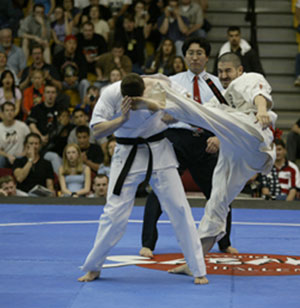
Karate was first introduced to American service men after World War II by Japanese and Okinawan karate masters.
References
- 1 2 Farkas, Emil (1983). Martial Arts : Traditions, History, People. Gallery Books. ISBN 9780831758059. OCLC 8627221.
- 1 2 3 4 5 6 7 8 Tugend, Tom (30 June 2005). "Menches You Don't Want to Mess With". Jewish Journal. Retrieved 16 January 2014.
- ↑ "Beverly Hills Karate Academy - About Us". Beverly Hills Karate Academy -. Retrieved 16 January 2014.
- 1 2 3 4 "Double trouble: Hungarian native Emil Farkas' martial arts training made him 'Sensei to the Stars' and he's started a second career as a writer". Los Angeles Business Journal. 9 August 2010.
{{cite web}}: Missing or empty|url=(help) - ↑ Brown, Mike (2008). Tearing Down the Wall of Sound: The Rise and Fall of Phil Spector. Random House LLC. p. 187. ISBN 9781400076611.
- ↑ Robert Kosberg (2011). How to Sell Your Idea to Hollywood. AuthorHouse. p. 15. ISBN 9781463412562.
- 1 2 Sobel, Stuart (September 1978). "Emil Farkas vs. the Amazing Spiderman". Inside Kung Fu. 5 (4).
- ↑ Emil Farkas; Joseph Jennings (1989). Combat shotokan (VHS). Panther Productions.
- ↑ Emil Farkas; Don Warrener (2003). American Masters & Champions of the Martial Arts (DVD). Mastersline Video Productions.
- ↑ Emil Farkas; Y. Ishimoto (2000). Encyclopedia Of Self Defence (VHS). Rising Sun Productions.
- ↑ Farkas, Emil (1977). The Complete Martial Arts Catalogue. Simon and Schuster. ISBN 9780671226688. OCLC 2798261.
- ↑ Farkas, Emil (1978). Fight Back : A Woman's Guide to Self-defense . Holt, Rinehart and Winston. ISBN 9780030210518. OCLC 3705957.
- ↑ Farkas, Emil (1981). The Overlook Martial Arts Dictionary. Overlook Press. ISBN 9780879511333. OCLC 7307696.
- ↑ Farkas, Emil (1980). Training and Fighting Skills. Unique Publications. ISBN 9780865680159. OCLC 7735219.
- ↑ Farkas, Emil (1984). The Martial Arts Dictionary. Allison & Busby. ISBN 9780850315981. OCLC 154166090.
- ↑ Farkas, Emil (1993). Mujeres, defiéndanse : no más víctimas indefensas : expertos les enseñan cómo dominar al agresor (Women Defend yourself: no more helpless victims: experts teach you how to master the aggressor). Edamex. ISBN 9789684096820. OCLC 28988737.
- ↑ Farkas, Emil (1993). The Original Martial Arts Encyclopedia: Tradition, History, Pioneers. Pro-Action Pub. ISBN 9780961512637. OCLC 28100847.
- ↑ Farkas, Emil (2011). The Original Martial Arts Encyclopedia: A Century of Martial Arts Worldwide. Trans-Euro Film Trust. ISBN 9781478351788.